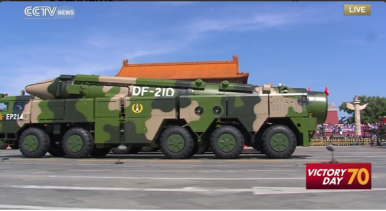By Ankit Panda
 This week, U.S. officials have told media here that China has, for the first known time, conducted tests of unspecified anti-ship ballistic missiles into its near seas—specifically the South China Sea this time. The development marks an important new kind of Chinese military activity in the area.
This week, U.S. officials have told media here that China has, for the first known time, conducted tests of unspecified anti-ship ballistic missiles into its near seas—specifically the South China Sea this time. The development marks an important new kind of Chinese military activity in the area.
Amid this development, it’s important to ascertain where exactly the People’s Liberation Army Rocket Force may have conducted its latest test launches. The first launch likely took place on this past Sunday, according to statements from anonymous U.S. officials who spoke to NBC News.
As I noted yesterday in The Diplomat, some open source evidence supports the notion that China did indeed conduct ASBM tests into the South China Sea this weekend.
Two data points, including a Notice to Airman that cordoned off a patch of airspace southeast of Hainan Island and a maritime exclusion zone announced recently by the Hainan Maritime Safety Administration, paint a picture of a ballistic missile test. (See this helpful map from Henri Kenhmann at East Pendulum.)
The missile in question—probably either a DF-21D, the anti-ship variant of the DF-21 that has long been a subject of curiosity for American analysts of the Chinese military, or the DF-26 ASBM variant—may have been launched from Hainan.
In fact, Sunday’s ASBM test may have inaugurated the PLARF’s new base on Hainan Island, which is China’s southernmost province, adjacent to the South China sea.
As analysts noted last year, a new PLARF base has been established some 10 kilometers west of Danzhou city on Hainan. The base’s location makes it an excellent candidate site for a possible ASBM launch that would have flown through the NOTAM zone and splashed down in the maritime exclusion zone.
The range from the Danzhou PLARF base to the maritime exclusion zone suggests that missile in question may have been the 1,500 kilometer-range DF-21D.
As I noted yesterday, the presence of the U.S. Navy’s Nimitz-class supercarrier USS Ronald Reagan and Japan’s JS Izumo helicopter carrier in the South China Sea over the past days would have made the ASBM test a potent signal of China’s resolve to defend its claims in the South China Sea.
The splashdown zone was due north of China’s seven artificial islands in the Spratly Islands. The U.S. Navy has conducted frequent freedom of navigation operations around those features, contesting Beijing’s excessive maritime claims.
American analysts have long been concerned with China’s growing militarization of the South China Sea, which would emerge as a major flashpoint in any future U.S.-China conflict.
Apart from the new ballistic missile base on Hainan, which gives the PLARF total coverage of the South China Sea with the DF-21D, China’s Spratly and Paracel Island-based features may allow it to improve its general domain awareness in the South China Sea.
Over-the-horizon radar emplacements, surface-to-air missile batteries, and anti-ship cruise missiles placed on these features would allow the People’s Liberation Army Navy to sustain an advantage in a conflict.
Additionally, intelligence, surveillance, and reconnaissance capabilities based on China’s South China Sea possessions may serve to cue and guide the DF-21D’s payload, improving the PLARF’s ability to strike relatively fast-moving targets like U.S. warships.
No comments:
Post a Comment